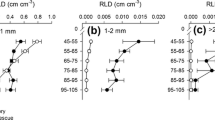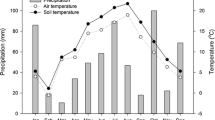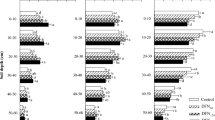Abstract
Aims
Plant root traits affect soil biopore (BP) formation. Aims of this study were to measure the effects of fodder crop species with contrasting root traits and duration of cropping on BP density (BPD), and also to address the consistency of these effects over different years focusing on the effects of root decay.
Methods
Soil BPD was quantified after growing three perennial fodder crop species with contrasting root systems, namely, lucerne (Medicago sativa L.), chicory (Cichorium intybus L.) and tall fescue (Festuca arundinacea Schreb.) for 1, 2, and 3 years with 2 years fallow in two repeated field trials from 2007 to 2014.
Results
Total BPD after taprooted fodder crops (421 ± 14 m−1) was significantly higher compared with fibrous-rooted crops (337 ± 12 m−1). Cropping duration did not affect soil BPD. On average, density of medium-sized BP (BPmed; 2–5 mm) increased 14 % after 2 years of fallow, whereas BPD decreased by 5 % for coarse-sized BP (BPcor; >5 mm) after the fallow.
Conclusions
Taprooted fodder crops enhanced BP formation into subsoil. Accurate assessment of biopores (BPs) and their persistence must take account of the temporal dynamics, including effects of root decay.






Similar content being viewed by others
References
Al-Kaisi MM, Yin X, Licht MA (2005) Soil carbon and nitrogen changes as influenced by tillage and cropping systems in some Iowa soils. Agric Ecosyst Environ 105:635–647. doi:10.1016/j.agee.2004.08.002
Altikat S, Celik A (2011) The effects of tillage and intra-row compaction on seedbed properties and red lentil emergence under dry land conditions. Soil Tillage Res 114:1–8. doi:10.1016/j.still.2011.03.003
Angers DA, Caron J (1998) Plant-induced changes in soil structure: processes and feedbacks. Biogeochemistry 42:55–72. doi:10.1023/A:1005944025343
Arora B, Mohanty BP, McGuire JT (2011) Inverse estimation of parameters for multidomain flow models in soil columns with different macropore densities. Water Resour Res 47:W04512. doi:10.1029/2010wr009451
Athmann M, Kautz T, Pude R, Köpke U (2013) Root growth in biopores—evaluation with in situ endoscopy. Plant Soil 371:179–190. doi:10.1007/s11104-013-1673-5
Atwell BJ (1990) The effect of soil compaction on wheat during early tillering. New Phytol 115:29–35. doi:10.1111/j.1469-8137.1990.tb00918.x
Bakht J, Shafi M, Jan MT, Shah Z (2009) Influence of crop residue management, cropping system and N fertilizer on soil N and C dynamics and sustainable wheat (Triticum aestivum L.) production. Soil Tillage Res 104:233–240. doi:10.1016/j.still.2009.02.006
Batey T (2009) Soil compaction and soil management - a review. Soil Use Manag 25:335–345. doi:10.1111/j.1475-2743.2009.00236.x
Batey T, McKenzie DC (2006) Soil compaction: identification directly in the field. Soil Use Manag 22:123–131. doi:10.1111/j.1475-2743.2006.00017.x
Bell LW, Sparling B, Tenuta M, Entz MH (2012) Soil profile carbon and nutrient stocks under long-term conventional and organic crop and alfalfa-crop rotations and re-established grassland. Agric Ecosyst Environ 158:156–163. doi:10.1016/j.agee.2012.06.006
Binet F, Hallaire V, Curmi P (1997) Agricultural practices and the spatial distribution of earthworms in maize fields. Relationships between earthworm abundance, maize plants and soil compaction. Soil Biol Biochem 29:577–583. doi:10.1016/s0038-0717(96)00182-4
Bodner G, Leitner D, Nakhforoosh A et al (2013) A statistical approach to root system classification. Front Plant Sci 4:292. doi:10.3389/fpls.2013.00292
Bonkowski M, Griffiths BS, Ritz K (2000) Food preferences of earthworms for soil fungi. Pedobiologia Int J Soil Biol 44:666–676. doi:10.1078/S0031-4056(04)70080-3
Bouché MB (1975) Action de la faune sur les états de la matière organique dans les ecosystèmes. In: Kilbertius G, Reisinger O, Mourey A et al (eds), Humification et biodégradation. Pierron, Sarreguemines, pp 157–168
Brown GG, Barois I, Lavelle P (2000) Regulation of soil organic matter dynamics and microbial activity in the drilosphere and the role of interactions with other edaphic functional domains. Eur J Soil Biol 36:177–198. doi:10.1016/s1164-5563(00)01062-1
Carrow RN (1996) Drought avoidance characteristics of diverse tall fescue cultivars. Crop Sci 36:371–377. doi:10.2135/cropsci1996.0011183X003600020026x
Chikoye D, Ekeleme F, Lum AF, Schulz S (2008) Legume–maize rotation and nitrogen effects on weed performance in the humid and subhumid tropics of West Africa. Crop Prot 27:638–647. doi:10.1016/j.cropro.2007.09.007
Clark GJ, Dodgshun N, Sale PWG, Tang C (2007) Changes in chemical and biological properties of a sodic clay subsoil with addition of organic amendments. Soil Biol Biochem 39:2806–2817. doi:10.1016/j.soilbio.2007.06.003
Cresswell HP, Kirkegaard JA (1995) Subsoil amelioration by plant-roots - the process and the evidence. Aust J Soil Res 33:221–239. doi:10.1071/SR9950221
Crews TE, Peoples MB (2004) Legume versus fertilizer sources of nitrogen: ecological tradeoffs and human needs. Agric Ecosyst Environ 102:279–297. doi:10.1016/j.agee.2003.09.018
Devliegher W, Verstraete W (1997) Microorganisms and soil physico-chemical conditions in the drilosphere of Lumbricus terrestris. Soil Biol Biochem 29:1721–1729. doi:10.1016/s0038-0717(97)00068-0
Dexter AR (1991) Amelioration of soil by natural processes. Soil Tillage Res 20:87–100. doi:10.1016/0167-1987(91)90127-j
Diggle P (1983) Statistical analysis of spatial point patterns. Academic Press, London. pp 1–8
Ehlers W (1975) Observations on earthworm channels and infiltration on tilled and untilled loess soil. Soil Sci 119:242–249. doi:10.1097/00010694-197503000-00010
Ehlers W, Köpke U, Hesse F, Böhm W (1983) Penetration resistance and root growth of oats in tilled and untilled loess soil. Soil Tillage Res 3:261–275. doi:10.1016/0167-1987(83)90027-2
Fitter AH (1987) An architectural approach to the comparative ecology of plant root systems. New Phytol 106:61–77. doi:10.1111/j.1469-8137.1987.tb04683.x
Gaiser T, Perkons U, Küper PM et al (2012) Evidence of improved water uptake from subsoil by spring wheat following lucerne in a temperate humid climate. Field Crop Res 126:56–62. doi:10.1016/j.fcr.2011.09.019
Gaiser T, Perkons U, Küpper PM, Kautz T (2013) Modeling biopore effects on root growth and biomass production on soils with pronounced sub-soil clay accumulation. Ecol Model 256:6–15. doi: 10.1016/j.ecolmodel.2013.02.016
Gentile RM, Martino DL, Entz MH (2005) Influence of perennial forages on subsoil organic carbon in a long-term rotation study in Uruguay. Agric Ecosyst Environ 105:419–423. doi:10.1016/j.agee.2004.05.002
Govaerts B, Mezzalama M, Sayre KD et al (2006) Long-term consequences of tillage, residue management, and crop rotation on maize/wheat root rot and nematode populations in subtropical highlands. Appl Soil Ecol 32:305–315. doi:10.1016/j.apsoil.2005.07.010
Gunn A (1992) The use of mustard to estimate earthworm populations. Pedobiologia Int J Soil Biol 36:65–67
Hagedorn F, Bundt M (2002) The age of preferential flow paths. Geoderma 108:119–132. doi:10.1016/S0016-7061(02)00129-5
Hartmann P, Zink A, Fleige H, Horn R (2012) Effect of compaction, tillage and climate change on soil water balance of Arable Luvisols in Northwest Germany. Soil Tillage Res 124:211–218. doi:10.1016/j.still.2012.06.004
Hatano R, Iwanaga K, Okajima H, Sakuma T (1988) Relationship between the distribution of soil macropores and root elongation. Soil Sci Plant Nutr 34:535–546. doi:10.1080/00380768.1988.10416469
Hiltbrunner J, Liedgens M, Bloch L et al (2007) Legume cover crops as living mulches for winter wheat: components of biomass and the control of weeds. Eur J Agron 26:21–29. doi:10.1016/j.eja.2006.08.002
Hinsinger P, Bengough AG, Vetterlein D, Young IM (2009) Rhizosphere: biophysics, biogeochemistry and ecological relevance. Plant Soil 321:117–152. doi:10.1007/s11104-008-9885-9
Hutchings MJ, John EA (2003) Distribution of roots in soil, and root foraging activity. In: de Kroon H, Visser EJW (eds) Root ecology. Springer Berlin Heidelberg, Berlin, Heidelberg, pp 33–60. doi:10.1007/978-3-662-09784-7_2
IUSS Working Group WRB (2006) World reference base for soil resources 2006 World soil resources report No. 103, 2nd edn. FAO, Rome
Jakobsen BE, Dexter AR (1988) Influence of biopores on root growth, water uptake and grain yield of wheat (Triticum aestivum) based on predictions from a computer model. Biol Fertil Soils 6:315–321. doi:10.1007/BF00261020
Jones DL, Hodge A, Kuzyakov Y (2004) Plant and mycorrhizal regulation of rhizodeposition. New Phytol 163:459–480. doi:10.1111/j.1469-8137.2004.01130.x
Kaiser HF (1960) The application of electronic computers to factor analysis. Educ Psychol Meas 20:141–151. doi:10.1177/001316446002000116
Kautz T (2014) Research on subsoil biopores and their functions in organically managed soils: A review. Renew Agric Food Syst. doi:10.1017/S1742170513000549
Kautz T, Amelung W, Ewert F et al (2013a) Nutrient acquisition from arable subsoils in temperate climates: A review. Soil Biol Biochem 57:1003–1022. doi:10.1016/j.soilbio.2012.09.014
Kautz T, Perkons U, Athmann M et al (2013b) Barley roots are not constrained to large-sized biopores in the subsoil of a deep Haplic Luvisol. Biol Fertil Soils 49:959–963. doi:10.1007/s00374-013-0783-9
Kautz T, Lüsebrink M, Pätzold S et al (2014) Contribution of anecic earthworms to biopore formation during cultivation of perennial ley crops. Pedobiologia Int J Soil Biol 57:47–52. doi:10.1016/j.pedobi.2013.09.008
Kelner DJ, Vessey JK, Entz MH (1997) The nitrogen dynamics of 1-, 2- and 3-year stands of alfalfa in a cropping system. Agric Ecosyst Environ 64:1–10. doi:10.1016/S0167-8809(97)00019-4
Kirkegaard JA, Lilley JM, Howe GN, Graham JM (2007) Impact of subsoil water use on wheat yield. Aust J Agric Res 58:303–315. doi:10.1071/AR06285
Köpke U (1995) Nutrient management in organic farming systems: the case of nitrogen. Biol Agric Hortic 11:15–29. doi:10.1080/01448765.1995.9754690
Leij FJ, Ghezzehei TA, Or D (2002) Analytical models for soil pore-size distribution after tillage. Soil Sci Soc Am J 66:1104–1114. doi:10.2136/sssaj2002.1104
Lynch JP, Wojciechowski T (2015) Opportunities and challenges in the subsoil: pathways to deeper rooted crops. J Exp Bot 66:2199–2210. doi:10.1093/jxb/eru508
Materechera SA, Alston AM, Kirby JM, Dexter AR (1992) Influence of root diameter on the penetration of seminal roots into a compacted subsoil. Plant Soil 144:297–303. doi:10.1007/BF00012888
McCallum MH, Kirkegaard JA, Green TW et al (2004) Improved subsoil macroporosity following perennial pastures. Aust J Exp Agric 44:299–307. doi:10.1071/EA03076
Mertens SK, Van den Bosch F, Heesterbeek J (2002) Weed populations and crop rotations: exploring dynamics of a structured periodic system. Ecol Appl 12:1125–1141. doi:10.1890/1051-0761(2002)012[1125:WPACRE]2.0.CO;2
Mueller UG, Gerardo NM, Aanen DK et al (2005) The evolution of agriculture in insects. Annu Rev Ecol Evol Syst 36:563–595. doi:10.1146/annurev.ecolsys.36.102003.152626
Nuttall JG, Davies SL, Armstrong RA, Peoples MB (2008) Testing the primer-plant concept: wheat yields can be increased on alkaline sodic soils when an effective primer phase is used. Aust J Agric Res 59:331–338. doi:10.1071/AR07287
Pagenkemper SK, Athmann M, Uteau D, et al (2014) The effect of earthworm activity on soil bioporosity – Investigated with X-ray computed tomography and endoscopy. Soil Tillage Res 146:79–88. doi:10.1016/j.still.2014.05.007
Pankhurst CE, Pierret A, Hawke BG, Kirby JM (2002) Microbiological and chemical properties of soil associated with macropores at different depths in a red-duplex soil in NSW Australia. Plant Soil 238:11–20. doi:10.1023/a:1014289632453
Passioura JB, Stirzaker RJ (1993) Feedforward responses of plants to physically inhospitable soil. In: Buxton DR, Shibles R, Forsberg RA et al (eds) International crop science I. Crop Science Society of America, Madison, pp 715-719. doi:10.2135/1993.internationalcropscience.c114
Perkons U, Kautz T, Uteau D et al (2014) Root-length densities of various annual crops following crops with contrasting root systems. Soil Tillage Res 137:50–57. doi:10.1016/j.still.2013.11.005
Pierret A, Moran CJ, Pankhurst CE (1999) Differentiation of soil properties related to the spatial association of wheat roots and soil macropores. Plant Soil 211:51–58. doi:10.1023/a:1004490800536
Pinheiro J, Bates D (2000) Mixed-effects models in S and S-PLUS. Springer, New York. pp 3–52. doi:10.1007/b98882
Rao MR, Mathuva MN (2000) Legumes for improving maize yields and income in semi-arid Kenya. Agric Ecosyst Environ 78:123–137. doi:10.1016/S0167-8809(99)00125-5
Riley H, Pommeresche R, Eltun R et al (2008) Soil structure, organic matter and earthworm activity in a comparison of cropping systems with contrasting tillage, rotations, fertilizer levels and manure use. Agric Ecosyst Environ 124:275–284. doi:10.1016/j.agee.2007.11.002
Rochester IJ, Peoples MB, Hulugalle NR et al (2001) Using legumes to enhance nitrogen fertility and improve soil condition in cotton cropping systems. Field Crop Res 70:27–41. doi:10.1016/S0378-4290(00)00151-9
Roseberg RJ, McCoy EL (1990) Measurement of soil macropore air permeability. Soil Sci Soc Am J 54:969–974. doi:10.2136/sssaj1990.03615995005400040005x
Rumpel C, Kögel-Knabner I (2010) Deep soil organic matter—a key but poorly understood component of terrestrial C cycle. Plant Soil 338:143–158. doi:10.1007/s11104-010-0391-5
Sainju UM, Lenssen AW (2011) Dryland soil carbon dynamics under alfalfa and durum-forage cropping sequences. Soil Tillage Res 113:30–37. doi:10.1016/j.still.2011.02.002
Smethurst JA, Clarke D, Powrie W (2012) Factors controlling the seasonal variation in soil water content and pore water pressures within a lightly vegetated clay slope. Geotechnique 62:429–446. doi:10.1680/geot.10.P.097
Stewart JB, Moran CJ, Wood JT (1999) Macropore sheath: quantification of plant root and soil macropore association. Plant Soil 211:59–67. doi:10.1023/A:1004405422847
Stirzaker RJ, Passioura JB, Wilms Y (1996) Soil structure and plant growth: impact of bulk density and biopores. Plant Soil 185:151–162. doi:10.1007/bf02257571
Taboada MA, Micucci FG, Cosentino DJ, Lavado RS (1998) Comparison of compaction induced by conventional and zero tillage in two soils of the Rolling Pampa of Argentina. Soil Tillage Res 49:57–63. doi:10.1016/S0167-1987(98)00132-9
Uksa M, Fischer D, Welzl G et al (2014) Community structure of prokaryotes and their functional potential in subsoils is more affected by spatial heterogeneity than by temporal variations. Soil Biol Biochem 75:197–201. doi:10.1016/j.soilbio.2014.04.018
Valentine TA, Hallett PD, Binnie K et al (2012) Soil strength and macropore volume limit root elongation rates in many UK agricultural soils. Ann Bot Lond 110:259–270. doi:10.1093/Aob/Mcs118
van Kessel C, Hartley C (2000) Agricultural management of grain legumes: has it led to an increase in nitrogen fixation? Field Crop Res 65:165–181. doi:10.1016/S0378-4290(99)00085-4
van Noordwijk M, Brouwer G, Meijboom F et al (2000) Trench profile techniques and core break methods. In: Smit AL, Bengough AG, Engels C et al (eds) Root methods. Springer Science & Business Media, Berlin, pp 211–233
Vancampenhout K, De Vos B, Wouters K et al (2012) Organic matter of subsoil horizons under broadleaved forest: highly processed or labile and plant-derived? Soil Biol Biochem 50:40–46. doi:10.1016/j.soilbio.2012.03.005
Vetterlein D, Kühn T, Kaiser K, Jahn R (2013) Illite transformation and potassium release upon changes in composition of the rhizophere soil solution. Plant Soil 371:267–279. doi:10.1007/s11104-013-1680-6
Vinther FP, Eiland F, Lind A-M, Elsgaard L (1999) Microbial biomass and numbers of denitrifiers related to macropore channels in agricultural and forest soils. Soil Biol Biochem 31:603–611. doi:10.1016/s0038-0717(98)00165-5
Volkmar KM (1996) Effects of biopores on the growth and N-uptake of wheat at three levels of soil moisture. Can J Soil Sci 76:453–458. doi:10.1007/s00248-012-0132-9
White RH, Bruneau AH, Cowett TJ (1993) Drought resistance of diverse tall fescue cultivars. Int Turfgrass Soc Res J 7:607–613
Whiteley GM, Dexter AR (1982) Root development and growth of oilseed, wheat and pea crops on tilled and non-tilled soil. Soil Tillage Res 2:379–393. doi:10.1016/0167-1987(82)90006-X
Whiteley GM, Dexter AR (1983) Behavior of roots in cracks between soil peds. Plant Soil 74:153–162. doi:10.1007/Bf02143606
Wuest SB (2001) Soil biopore estimation: effects of tillage, nitrogen, and photographic resolution. Soil Tillage Res 62:111–116. doi:10.1016/s0167-1987(01)00218-5
Zotarelli L, Zatorre NP, Boddey RM et al (2012) Influence of no-tillage and frequency of a green manure legume in crop rotations for balancing N outputs and preserving soil organic C stocks. Field Crop Res 132:185–195. doi:10.1016/j.fcr.2011.12.013
Acknowledgments
We are grateful to the German Research Foundation (Deutsche Forschungsgemeinschaft, DFG) for financing this study under the research units DFG-FOR 1320 and PAK 888. We are also indebted to Dr. Stefan Pätzold for the detailed explanation of the soil condition at the experimental site. We also would like to express our deep appreciation for the contribution of students, especially, Annette Eickelkamp, Tobias Lühring and David Büchler. Essential support from several technicians working at the Institute of Organic Agriculture (IOL), especially Christian Dahn and Frank Täufer, and several others at Campus Klein-Altendorf is also much appreciated.
Compliance with ethical standards
ᅟ
Funding
This study was funded by Deutsche Forschungsgemeinschaft (DFG-FOR 1320).
Conflict of interest
The authors declare that they have no conflict of interest.
Author information
Authors and Affiliations
Corresponding author
Additional information
Responsible Editor: John A. Kirkegaard.
Rights and permissions
About this article
Cite this article
Han, E., Kautz, T., Perkons, U. et al. Quantification of soil biopore density after perennial fodder cropping. Plant Soil 394, 73–85 (2015). https://doi.org/10.1007/s11104-015-2488-3
Received:
Accepted:
Published:
Issue Date:
DOI: https://doi.org/10.1007/s11104-015-2488-3




